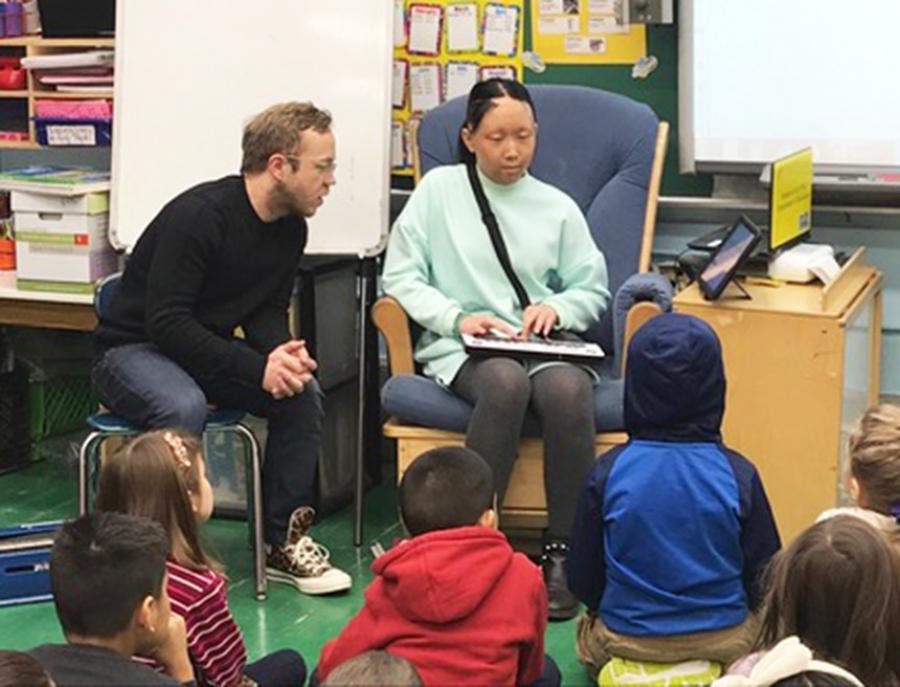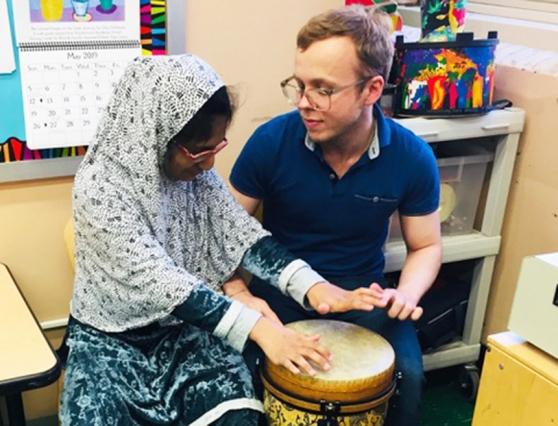Ten years ago, Jonathan Hooper was a first-year teacher in Tennessee who had a struggling 5th-grader with a visual impairment. The student was reading below grade level and frequently absent. Hooper did research on accommodations and implemented them for the student.
It was life-changing for both the student and Hooper.
The student began reading at grade level and loving the school experience. And it set Hooper on his journey toward focusing on students with that disability. Now an itinerant teacher of students with visual impairments in New York City, Hooper was named the Braille Institute’s Teacher of the Year for 2020.
Hooper, a member of the UFT’s Vision Education Services Chapter, said he learned that “with some accommodations, students with visual impairments can thrive.”
After a stint teaching at the Tennessee School for the Blind, Hooper now works one-on-one with students in all grade levels all over New York City on “anything they need to succeed.” Hooper has a range of strategies: teaching students how to use magnification software, screen readers and other adaptive devices; teaching them how to read and write in Braille; and even building their skills in self-advocacy so they can get their academic and social needs met without a teacher like him.
“There’s so much diversity, and it keeps things interesting,” said Hooper. “I might have a Braille user in a high school physics classroom. Then I go to another school, and I’m working with a 2nd-grader with low vision and we’re talking about using a magnifier.”
Hooper’s work with students was just one reason he was honored with the Braille Institute’s national award. He was also cited for webinars he has presented to other educators and parents and for his contributions to the New York event of the Braille Institute’s annual Braille Challenge, a competition that encourages students to develop Braille literacy skills.
When you talk to Hooper, the conversation always comes back to collaboration between educators and families, which he says can have a big impact on a student’s life and is his favorite part of working in New York City.
“If I tell a gym teacher, here are some balls with bells in them, my student can participate in gym class,” he said.
At staff meetings, there are 80 teachers of students with visual impairments in the same room, a number unheard of in many school districts, and they support each other.
“I help teachers who have Braille students and need tips,” Hooper said, while other teachers support him when he works with students who have a visual impairment alongside other disabilities, for example.
Remote learning has been especially difficult for tactile learners, who don’t read print and instead use tools including Braille. Some Department of Education learning platforms aren’t accessible to students who use screen reading software, which reads the text on the screen aloud for people who can’t see it. And, since he can’t be in the classroom, Hooper has trouble giving teachers adjustments, such as suggesting they say something aloud instead of pointing to it on a whiteboard.
But Hooper has also found the upside of remote learning, including better communication with parents. Hooper often suggests students with cortical vision impairment turn off lights and read an illuminated tablet, but parents are apprehensive. “A week later, they have blackout curtains installed,” he said, and the parents tell him they didn’t realize how much the accommodation benefited their child until they saw it in action at home.
“That’s going to make them better advocates for their kids,” Hooper said.
As the city navigates a challenging winter, Hooper wants other educators to know teachers of students with visual impairments can help students with vision challenges.
“It’s important for us to be included in educational teams and planning because we know the effects of visual impairment on all sorts of things, from social to academic to career education,” he said. “Given the appropriate accommodations, students with visual impairments can achieve right alongside their sighted peers.”


